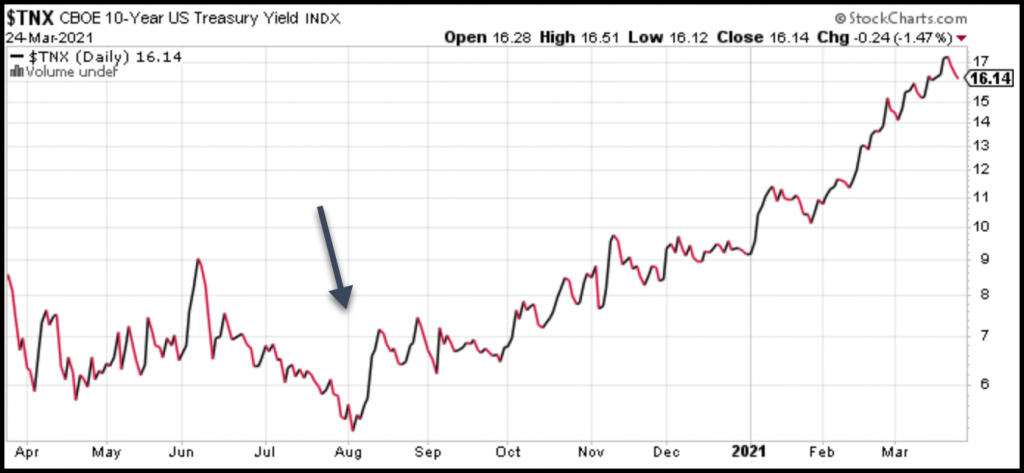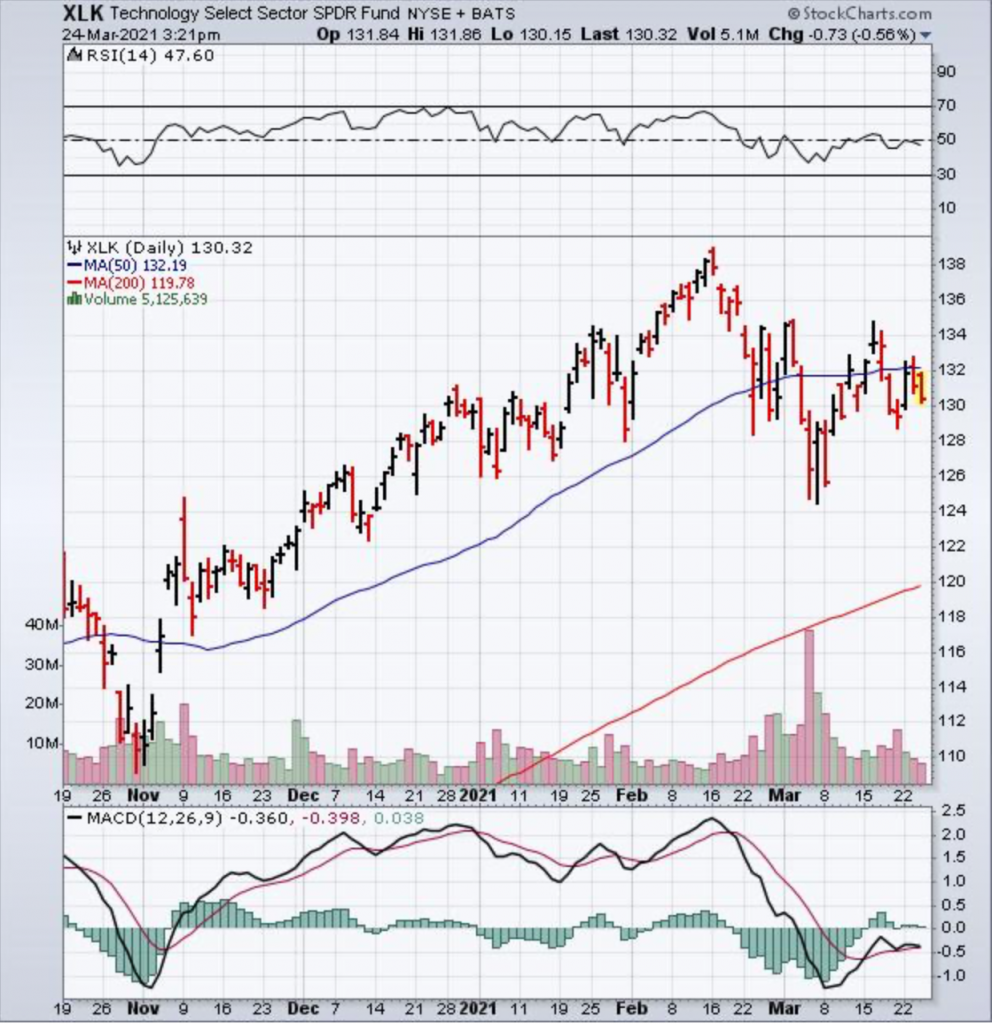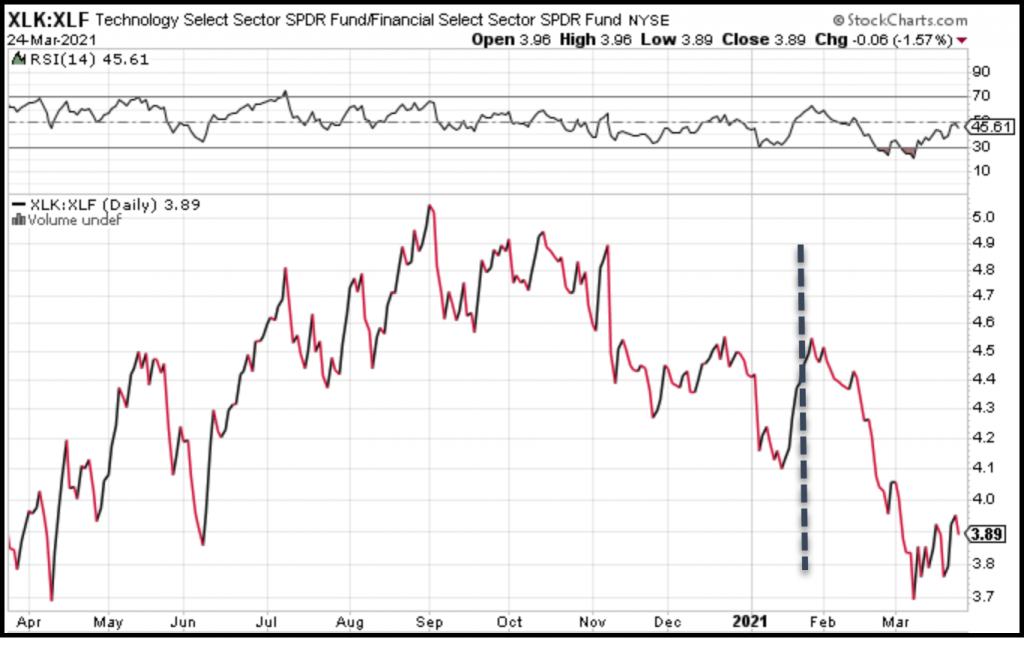Related Blogs
March 26, 2021 | Michael Reilly
 While the Dow Jones Industrial Average (DJIA) continues to flirt with record highs, the tech-dominated Nasdaq is under a lot of pressure these days.
While the Dow Jones Industrial Average (DJIA) continues to flirt with record highs, the tech-dominated Nasdaq is under a lot of pressure these days.
If you’re wondering why – the reason is very simple – rising yields.
You see, large tech growth stocks are especially vulnerable to rising yields. As yields move up, costs rise, impacting tech profits, making tech stocks less attractive to potential investors.
And make no mistake, yields are rising. So either learn to adapt to the changing investment landscape or be prepared for a rocky ride.
I have to believe there are plenty of investors reading this post that haven’t been around long enough to have invested in a rising rate environment and have no idea how to navigate it. After all, it’s been more than a decade since we’ve seen any meaningful rise in rates.
You can consider this a note or even a warning to both new and seasoned investors- if you stay wedded to what worked in the previous decade, you’re in trouble for the next one.
We’re living in a post covid world. Governments around the world intend to spend their way out of the covid hangover – they’ll use any fiscal and monetary policy trick up their sleeve to do it.
These are major shifts in policy and the implications cannot be understated. Global markets will be impacted.
Asset classes relationships that you thought you understood will likely change. Yesterday’s laggards will become tomorrow’s leaders and vice versa.
So, if you still think the market is only about the U.S., about FANG stocks, Tesla, or crypto, think again.
Big tech is no longer top dog – so the question is – are they just taking a much-deserved breather or this is a legit changing of the guard.
It’s indisputable that we’re seeing bond yields rising and a steepening of the yield curve. That makes me believe techs days of dominance may be a thing of the past – at least relative to the alternatives.
Let me paint a picture for you – beginning with bond yields.
Below is an image of 10 year Treasury yields. Since August of 2020, yields began to rise pretty consistently. Since January, the 10yr yield has risen dramatically, and the rate at which yields have jumped is sending shock waves through equity markets.

Take a look at the price chart below of the Invesco ETF – QQQ, representing the Nasdaq. The “Q’s” as they are called, are struggling, mainly because the ETF and the index it tracks are dominated by tech stocks.
Top holdings of QQQ

Here’s a price chart of the QQQ. Since early February of this year, as yields began to really spike higher, the price of Q’s has fallen and is struggling to break back above its 50-day average.

It’s a very similar picture as we look specifically at the Technology SPDR (XLK) acting as a broad-based sector proxy – it too is trading below its 50-day moving average after turning down in mid-February.

And here’s a chart of the VanEck Vectors Semiconductor ETF (SMH) – looks a lot like the other two charts, prices falling since February and running into resistance at its 50 moving average.

What you can’t see from the charts above is that Technology stocks peaked in August – September of 2020, about the same time as bond yields bottomed and began another leg higher – coincidence, I don’t think so.

Now let’s look at things from the perspective of relative strength. Below is a relative strength chart comparing Tech (XLK) to the broader S&P 500 (SPY).
If tech is still the dominant player in the market, we’d expect to see a rising line, indicating strength favors Tech over SPY. But that’s not what we are seeing. The relative strength line is descending – indicating tech is losing strength relative to the broader stock market.

Since February, Tech stocks have been losing their relative strength grip vs the broader market.
The next two charts are also relative strength ratio charts, comparing the relative strength of this former leader (Tech) to sectors that are beneficiaries of higher rates – Financials and Energy


In November of 2020, the relationship between tech and energy stocks and tech and financials reversed course – as Technology weakened on a relative strength basis vs. these two alternatives Energy and Financials.
Remember, relative strength comparisons like the ones above, are about the relationship one stock or sector has when compared to an alternative. In this case, our comparisons are between technology stocks and financial stocks or technology stocks vs energy stocks.
The nature of relative strength tells us one stock or sector is moving up by more or down by less than what it is being compared to. Right now, tech stocks are moving down by more or up by less than the two alternatives in financials and energy.
I’ve marked on both charts where yields really started to accelerate higher in February – It’s the same area that Tech began to fall on a relative basis.
The underperformance of technology relative to Financials and Energy should be a warning sign to investors not to grow attached to what worked in the past. Lose that bias.
We typically don’t just see outperformance on a relative basis, we expect to see outperformance on an absolute basis as well.
 Courtesy of Nasdaq/Dorsey Wright
Courtesy of Nasdaq/Dorsey Wright
So it doesn’t come as a surprise that while technology (XLK) has grinded its way to a +1.42% year-to-date return (as of 03/22/2021), Financials and Energy have gained 14.08% and 28.07%, respectively, since January 1st.
This shift towards a rising interest rate environment can already be seen in rising inflation expectations, rising commodity prices (including energy) and a weakening US Dollar. If this continues, which history suggests is likely, it will eventually have a significant adverse effect on the US stock market – and yes, including technology.
To summarize:
Technology stocks generally don’t outperform many alternatives in a rising interest rate environment. So ask yourself why you’ll own them knowing there’s an opportunity cost to do so. Other sectors, including financials and energy, fortunes improve with rising rates.
The world is playing a new strategy – one that includes higher bond yields, fiscal stimulus and higher inflation. A successful investment strategy will include adapting to a changing investment climate. If these policies continue, expect to see further asset class and sector rotation moving forward.
Check back again as we continue to track these important developments across the globe.
Until next week….
Tags

Get Our FREE Guide
How to Find the Best Advisor for You
Learn how to choose an advisor that has your best interests in mind. You'll also be subscribed to ADAPT, Avalon’s free newsletter with updates on our strongest performing investment models and market insights from a responsible money management perspective.

